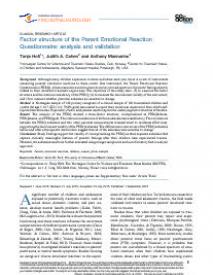Factor structure of the Parent Emotional Reaction Questionnaire: analysis and validation
Background: Although many children experience violence and abuse each year, there is a lack of instruments measuring parents’ emotional reactions to these events. One instrument, the Parent Emotional Reaction Questionnaire (PERQ), allows researchers and clinicians to survey a broad spectrum of parents’ feelings directly related to their children’s traumatic experiences. The objectives of this study were: (1) to examine the factor structure and the internal consistency of the PERQ; (2) to evaluate the discriminant validity of the instrument; and (3) to measure whether potential subscales are sensitive to change.
Method: A Norwegian sample of 120 primary caregivers of a clinical sample of 120 traumatized children and youths (M age=14.7, SD=2.2; 79.8% girls) were asked to report their emotional reactions to their child’s self-reported worst trauma. Exploratory factor analysis was used to explore the underlying factor structure of the data.
Results: The analysis of the PERQ showed a three-factor structure, conceptualized as PERQdistress, PERQshame, and PERQguilt. The internal consistencies of all three subscales were satisfactory. The correlations between the PERQ subscales and two other parental measurements revealed small to moderate effect sizes, supporting the discriminant validity of the PERQ subscales. The differences in sum scores of the PERQ subscales before and after a therapeutic intervention suggest that all of the subscales were sensitive to change.
Conclusions: Study findings support the validity of conceptualizing the PERQ as three separate subscales that capture clinically meaningful features of parents’ feelings after their children have experienced trauma. However, the subscales need to be further evaluated using a larger sample size and a confirmatory factor analytic approach.
Geachte bezoeker,
De informatie die u nu opvraagt, kan door psychotraumanet niet aan u worden getoond. Dit kan verschillende redenen hebben,
waarvan (bescherming van het) auteursrecht de meeste voorkomende is. Wanneer het mogelijk is om u door te verwijzen naar de bron
van deze informatie, dan ziet u hier onder een link naar die plek.
Als er geen link staat, kunt u contact opnemen met de bibliotheek,
die u verder op weg kan helpen.
Met vriendelijke groet,
Het psychotraumanet-team.
Reference:
Tonje Holt, Judith A. Cohen, & Anthony Mannarino | 2015
In: European journal of psychotraumatology, ISSN 2000-8066 | 6 | 28773
http://www.ejpt.net/index.php/ejpt/article/view/28733
In: European journal of psychotraumatology, ISSN 2000-8066 | 6 | 28773
http://www.ejpt.net/index.php/ejpt/article/view/28733


